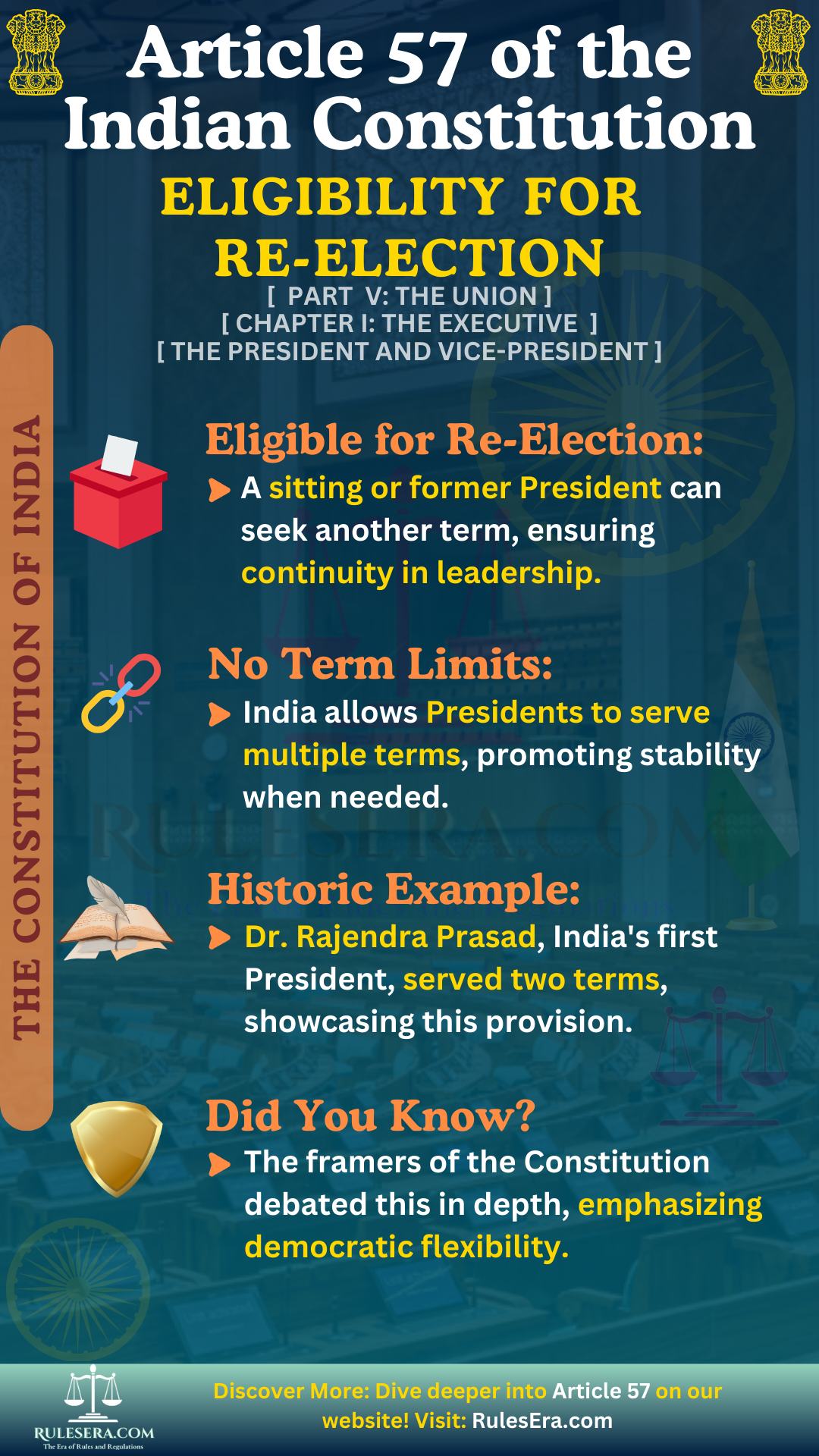Part V: The Union
Chapter I: The Executive
Article 57: Eligibility for Re-election

--- Original Article ---
A person who holds, or who has held, office as President shall, subject to the other provisions of this Constitution, be eligible for re-election to that office.
Explanation
Article 57 forms a crucial aspect of the democratic structure in India by allowing a sitting or former President to contest for re-election. This provision ensures that those who have demonstrated leadership as President can be considered for continued service if the electorate so desires. The re-election process is crucial for maintaining the office's integrity while balancing experience with the electorate's judgment.
Key Provisions
- Scope of Eligibility for Re-election: A person holding or having held the office of the President remains eligible for re-election to that position. This allows experienced individuals to continue serving if elected again.
- Constitutional Limitations: Eligibility is subject to other provisions of the Constitution, such as Article 58 (qualifications) and provisions related to impeachment or disqualification.
- No Term Limits: The Indian Constitution does not impose any maximum number of terms a person may serve as President, offering flexibility and continuity in leadership if re-elected.
Amendments and Real-Life Examples
- Amendments: Article 57 has not been amended, though changes in the overall electoral process, such as the Forty-second Amendment, impacted the framework of presidential elections.
- Real-Life Example: Dr. Rajendra Prasad is the best-known example, having been re-elected as President in 1957, serving two full terms. His re-election demonstrates the functioning of Article 57 in allowing a former President to seek and win another term.
Historical Significance
The provision of re-election under Article 57 allows continuity in leadership. Unlike countries like the United States, where Presidents can serve only two terms, India provides the flexibility for Presidents to continue if re-elected. This reflects the framers' belief in leaving the choice to the electoral college, thus ensuring democratic flexibility and continuity in leadership during critical times.
Legislative History
Article 57, originally drafted as Article 46, was debated and incorporated into the Constitution on December 13, 1948.
Debates and Deliberations
During the Constituent Assembly debates on Article 46 (now Article 57), Shri Krishna Chandra Sharma from United Province proposed the deletion of the words "once and only once" from the draft article. He argued that capable and efficient individuals should be allowed to serve a second term through re-election. The Assembly accepted this proposal, allowing Presidents to serve more than one term if re-elected.
Shri H. V. Kamath raised concerns regarding individuals who had been impeached from office. He proposed an amendment to make a person ineligible for the presidency if they had been removed from office by impeachment. Kamath expressed worry that without such a clause, an impeached President could potentially be re-elected after some years. Dr. B. R. Ambedkar addressed this concern, assuring Kamath that this issue would be considered when the disqualification provisions were discussed.
Furthermore, Shri Mahavir Tyagi introduced an amendment addressing the re-election eligibility of a Vice-President who had acted as or temporarily held the office of the President. Tyagi argued that such a Vice-President should not be barred from standing for the presidency more than once. However, the Chairman of the Drafting Committee deemed this proposal groundless, and the amendment was not accepted.
After these deliberations and amendments, Article 57 was adopted into the Constitution, enabling Presidents to be re-elected and ensuring the democratic right of the electorate to determine the leadership of the nation.
Frequently Asked Questions (FAQs):
Yes, according to Article 57, a person who holds or has held office as President is eligible for re-election, subject to the other provisions of the Constitution.
No, the Indian Constitution does not impose any maximum number of terms a person may serve as President, allowing for flexibility in leadership if re-elected.